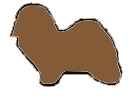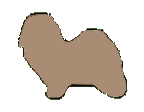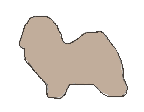
Dark Colours
Dark coat colours are black based (Eumelanin). There are two different expressions of dark colour possible. The dominant expression of the gene is black. A mutation in the gene that makes eumelanin causes a recessive expression which is brown. Other genes can further affect both. A silvering gene causes progressive lightening of the coat. One copy of the silvering gene lightens a little and two copies lightens a lot. A black colour base may silver to charcoal or silver. A brown colour base will silver to lighter variations of chocolate. There is more in depth information about this in the genetics pages. Photo examples of these dark based colours can be found in Gallery 3 (black based) and Gallery 9 (brown based)
Black based colours
 BLACK: Darkest colour in Havanese. Deep, jet black; dark, intense colour. The deepest black has no reddish or brown tones; it may give a blue sheen in photographs. Colour does not lighten. See photos in Gallery 3.
BLACK: Darkest colour in Havanese. Deep, jet black; dark, intense colour. The deepest black has no reddish or brown tones; it may give a blue sheen in photographs. Colour does not lighten. See photos in Gallery 3.
Puppies that appear soft black or that have subtle hues or undertones of colour throughout may go through some changes in colour over time as they mature.
 CHARCOAL or DARK SILVER: Puppies are born black. Due to the presence of one copy of the silvering gene, as the dog matures, the coat colour gradually lightens, developing a dark silver, steel, or charcoal cast.
CHARCOAL or DARK SILVER: Puppies are born black. Due to the presence of one copy of the silvering gene, as the dog matures, the coat colour gradually lightens, developing a dark silver, steel, or charcoal cast.
The colour change usually starts in adolescence or young adulthood and the complete process can take 12 to 24 months, or longer. The final coat colour ranges from medium to dark silver. See photos in gallery 3. Some people call this colour Blue (further elaborated as "black turned blue"). Rainbow reserves Blue for the dilute dog.
 SILVER: Puppies are born black and start to lighten at about 4 to 6 weeks of age. As the dog matures, the coat colour gradually lightens to pale shades of silver/grey. This colour change is due to having two copies of the silvering gene.
SILVER: Puppies are born black and start to lighten at about 4 to 6 weeks of age. As the dog matures, the coat colour gradually lightens to pale shades of silver/grey. This colour change is due to having two copies of the silvering gene.
It is the same process as charcoal above but the change starts earlier and the colour lightens more dramatically. Final colour may be assorted shades from light to medium silver/grey. See photos in gallery 3.
Brown based colours
 CHOCOLATE: Puppies are born brown. Chocolate coats may vary from a light milk chocolate colour to darker bittersweet chocolate colour. Brown dogs have matching brown pigment on nose, pads, eye rims and lips. There can be no black on the dog whatsoever.
CHOCOLATE: Puppies are born brown. Chocolate coats may vary from a light milk chocolate colour to darker bittersweet chocolate colour. Brown dogs have matching brown pigment on nose, pads, eye rims and lips. There can be no black on the dog whatsoever.
There is more information about pigment on chocolate dogs to be found in the pigment section of definitions. See photos in gallery 9.
 DARK CHOCOLATE SILVER: Puppies are born chocolate and lighten as they mature. One copy of the silvering gene, acting on the brown base, lightens the colour to a medium to dark Mocha colour.
DARK CHOCOLATE SILVER: Puppies are born chocolate and lighten as they mature. One copy of the silvering gene, acting on the brown base, lightens the colour to a medium to dark Mocha colour.
The gene responsible for the colour change, and the process, is exactly the same as that which occurs in charcoal. Silvering generally starts in adolescence to young adulthood and may progress over 2 to 3 years or longer. See photos in Gallery 9 .
 LIGHT CHOCOLATE SILVER: Puppies are born chocolate. Two copies of the silvering gene lighten the dog as it matures to a chocolate silver colour similar to a light coffee. Silvering starts very early and is generally complete at about 12-15 months of age.
LIGHT CHOCOLATE SILVER: Puppies are born chocolate. Two copies of the silvering gene lighten the dog as it matures to a chocolate silver colour similar to a light coffee. Silvering starts very early and is generally complete at about 12-15 months of age.
With two copies of the silvering gene, the change starts earlier and the colour lightens more dramatically than the darker chocolate silver above that has only one silvering gene. Final colour may be assorted shades from light to medium coffee.